Research on the Collection Characteristics of a Hydraulic Collector for Seafloor Massive Sulfides
Abstract
1. Introduction
2. Numerical Method
2.1. Governing Equation
2.2. Force Acting on Particles
2.2.1. Fluid–Particle Interaction
2.2.2. Particle Collision Force
2.3. CFD-DEM Coupling Method
3. Design Parameters and Modeling
3.1. Design Parameters
3.2. Numerical Modeling
3.2.1. Geometric Model and Mesh Model
3.2.2. Initial State of Particles
3.2.3. Numerical Setups
4. Results and Discussions
4.1. Analysis of Flow Field Characteristics
4.2. Ore Collection Mechanism
4.3. The Effect of Drum Speeds on Collection Characteristics
4.3.1. Flow Field Characteristics
4.3.2. Particle Dynamics Characteristics
4.3.3. The Influence of Drum Speed on Ore Collection Performance
5. Preliminary Assessment of Simulation Results
5.1. Experimental Setup and Materials
5.2. Experimental Assessment
6. Conclusions
- (1)
- For an SMS ore with a density of 2670 kg/m3 and a maximum diameter of 20 mm, effective collection can be achieved when the outlet flow velocity of the suction head is 3 m/s.
- (2)
- The collection process of deep-sea seafloor massive sulfide mainly goes through three stages: particle disturbance start-up, partial particle influx, and stable collection. The particle collection tracks have randomness. In addition, excessive rotation speed of the drum will cause particle splashing, which is unfavorable to the ore collection.
- (3)
- Appropriately increasing the drum rotation speed is conducive to improving the hydraulic ore collection efficiency, such as 45 r/min ore collection efficiency compared to 15 r/min to improve 11.2%. However, too high a rotational speed will reduce the ore collection performance. Therefore, in practical application, it is necessary to set the drum speed within a reasonable range.
- (4)
- The numerical results are in good agreement with the experimental results, which not only indicates the accuracy of the numerical simulation method but also demonstrates the feasibility of the collecting device.
Author Contributions
Funding
Institutional Review Board Statement
Informed Consent Statement
Data Availability Statement
Conflicts of Interest
References
- Lusty, P.A.J.; Murton, B.J. Deep-ocean mineral deposits: Metal resources and windows into earth processes. Elements 2018, 14, 301–306. [Google Scholar] [CrossRef]
- Petersen, S.; Krätschell, A.; Augustin, N.; Jamieson, J.; Hein, J.R.; Hannington, M.D. News from the seabed—Geological characteristics and resource potential of deep-sea mineral resources. Mar. Policy 2016, 70, 175–187. [Google Scholar] [CrossRef]
- Webber, A.P.; Roberts, S.; Murton, B.J.; Mills, R.A.; Hodgkinson, M.R.S. The formation of gold-rich seafloor sulfide deposits: Evidence from the beebe hydrothermal vent field, cayman trough. Geochem. Geophys. Geosyst. 2017, 18, 2011–2027. [Google Scholar] [CrossRef]
- Leng, D.X.; Shao, S.; Xie, Y.C.; Wang, H.H.; Liu, G.J. A brief review of recent progress on deep sea mining vehicle. Ocean Eng. 2021, 228, 108565. [Google Scholar] [CrossRef]
- Wu, Q.; Yang, J.M.; Lu, H.N.; Lu, W.Y.; Liu, L. Effects of heave motion on the dynamic performance of vertical transport system for deep sea mining. Appl. Ocean Res. 2020, 101, 102188. [Google Scholar] [CrossRef]
- Hein, J.R.; Mizell, K.K.A.; Conrad, T.A. Deep-ocean mineral deposits as a source of critical metals for high-and green-technology applications: Comparison with land-based resources. Ore Geol. Rev. 2013, 51, 1–14. [Google Scholar] [CrossRef]
- Tao, C.H.; Li, H.M.; Jin, X.B.; Zhou, J.P.; Wu, T.; He, Y.H.; Deng, X.; Gu, C.H.; Zhang, G.Y.; Liu, W.Y. Seafloor hydrothermal activity and polymetallic sulfide exploration on the southwest indian ridge. Sci. Bull. 2014, 59, 2266–2276. [Google Scholar] [CrossRef]
- Zhao, G.C.; Xiao, L.F.; Peng, T.; Zhang, M.Y. Experimental research on hydraulic collecting spherical particles in deep sea mining. Energies 2018, 11, 1938. [Google Scholar] [CrossRef]
- Xia, Q.; Jia, H.; Sun, J.; Cui, J. Study on flow characteristics of hydraulic suction of seabed ore particles. Processes 2023, 11, 1376. [Google Scholar] [CrossRef]
- Chen, Y.X.; Xiong, H.; Cheng, H. Experimental study on the incipient motion of a single spherical particle in hydraulic collecting. J. Cent. South Univ. (Sci. Technol.) 2019, 50, 2831–2839. [Google Scholar]
- Chen, Y.X.; Xiong, H.; Cheng, H.; Yu, C.L.; Xie, J.H. Effect of particle motion on the hydraulic collection of coarse spherical particles. Acta Mech. Sin. 2020, 36, 72–81. [Google Scholar] [CrossRef]
- Hong, S.; Choi, J.S.; Kim, J.H.; Yang, C.K. Experimental study on hydraulic performance of hybrid pick-up device of manganese nodule collector. In Proceedings of the Third ISOPE Ocean Mining Symposium, Goa, India, 8–10 November 1999; pp. 69–77. [Google Scholar]
- Yue, Z.Y.; Zhao, G.C.; Xiao, L.F.; Liu, M.Y. Comparative study on collection performance of three nodule collection methods in seawater and sediment-seawater mixture. Appl. Ocean Res. 2021, 110, 102606. [Google Scholar] [CrossRef]
- Jia, H.; Yang, J.; Su, X.; Wang, Y.; Wu, K. Flow characteristics and hydraulic lift of coandă effect-based pick-up method for polymetallic nodule. Coatings 2023, 13, 271. [Google Scholar] [CrossRef]
- Alhaddad, S.; Mehta, D.; Helmons, R. Mining of deep-seabed nodules using a coandă-effect-based collector. Results Eng. 2023, 17, 100852. [Google Scholar] [CrossRef]
- Wang, P.J.; Li, L.; Wu, J.B. Research on the lightweight structural optimization design of the front collector of the polymetallic nodule miner. Ocean Eng. 2023, 113275, 113275. [Google Scholar] [CrossRef]
- Xie, C.; Wang, L.; Yang, N.; Agee, C.; Chen, M.; Zheng, J.R.; Liu, J.; Chen, Y.X.; Xu, L.X.; Qu, Z.G.; et al. A compact design of underwater mining vehicle for the cobalt-rich crust with general support vessel part a: Prototype and tests. J. Mar. Sci. Eng. 2022, 10, 135. [Google Scholar] [CrossRef]
- Liu, S.J.; Hu, J.H.; Zhang, R.Q.; Dai, Y. Development of mining technology and equipment for seafloor massive sulfide deposits. Chin. J. Mech. Eng. 2016, 29, 863–870. [Google Scholar] [CrossRef]
- Orita, K.; Seiya, K.; Nakamura, S.; Igarashi, Y.; Shiokawa, S.; Nojiri, S.; Ueyama, Y.; Watanabe, K. Development of new mining machine for cobalt-rich ferromanganese crust and achievement of excavation and dredging test on the deep seafloor. In Proceedings of the Thirty-Second (2022) International Ocean and Polar Engineering Conference, Shanghai, China, 5–10 June 2022. [Google Scholar]
- Dai, H.; Li, Y.; Li, M.D. Experimental study on failure mechanical properties of two kinds of seafloor massive sulfides. Minerals 2021, 11, 1144. [Google Scholar] [CrossRef]
- Spagnoli, G.; Jahn, A.; Halbach, P. First results regarding the influence of mineralogy on the mechanical properties of seafloor massive sulfide samples. Eng. Geol. 2016, 214, 127–135. [Google Scholar] [CrossRef]
- Yamazaki, T.; Park, S. Relationships between geotechnical engineering properties and assay of seafloor massive sulfides. In Proceedings of the Thirteenth (2003) International Offshore and Polar Engineering Conference, Honolulu, HI, USA, 25–30 May 2003. [Google Scholar]
- Shama, R. Deep-Sea Minig; Springer International Publishing: Berlin/Heidelberg, Germany, 2017. [Google Scholar]
- Liu, S.J.; Hu, J.H.; Dai, Y.; Hu, Q.; Lv, T. Flow field analysis and parameter optimization of deep-sea collector of SMS. J. Cent. South Univ. (Sci. Technol.) 2017, 48, 1120–1198. [Google Scholar]
- Li, Y.; He, J. Numerical simulation of solid-liquid two-phase flow of the gathering process of seafloor massive sulfide. J. Cent. South Univ. (Sci. Technol.) 2022, 53, 461–470. [Google Scholar]
- Crowe, C.T.; Sommerfield, M.; Tsuji, Y. Multiphase Flows with Droplets and Particles; CRC Press: Boca Raton, FL, USA, 2012. [Google Scholar]
- Brown, P.P.; Lawler, D.F. Sphere drag and settling velocity revisited. J. Environ. Eng. 2003, 129, 222–231. [Google Scholar] [CrossRef]
- Mei, R. An approximate expression for the shear lift force on a spherical particle at finite reynolds number. Int. J. Multiph. Flow 1992, 18, 145–147. [Google Scholar] [CrossRef]
- Renzo, A.D.; Maio, F.P.D. Comparison of contact-force models for the simulation of collisions in dem-based granular flow codes. Chem. Eng. Sci. 2004, 59, 525–541. [Google Scholar] [CrossRef]



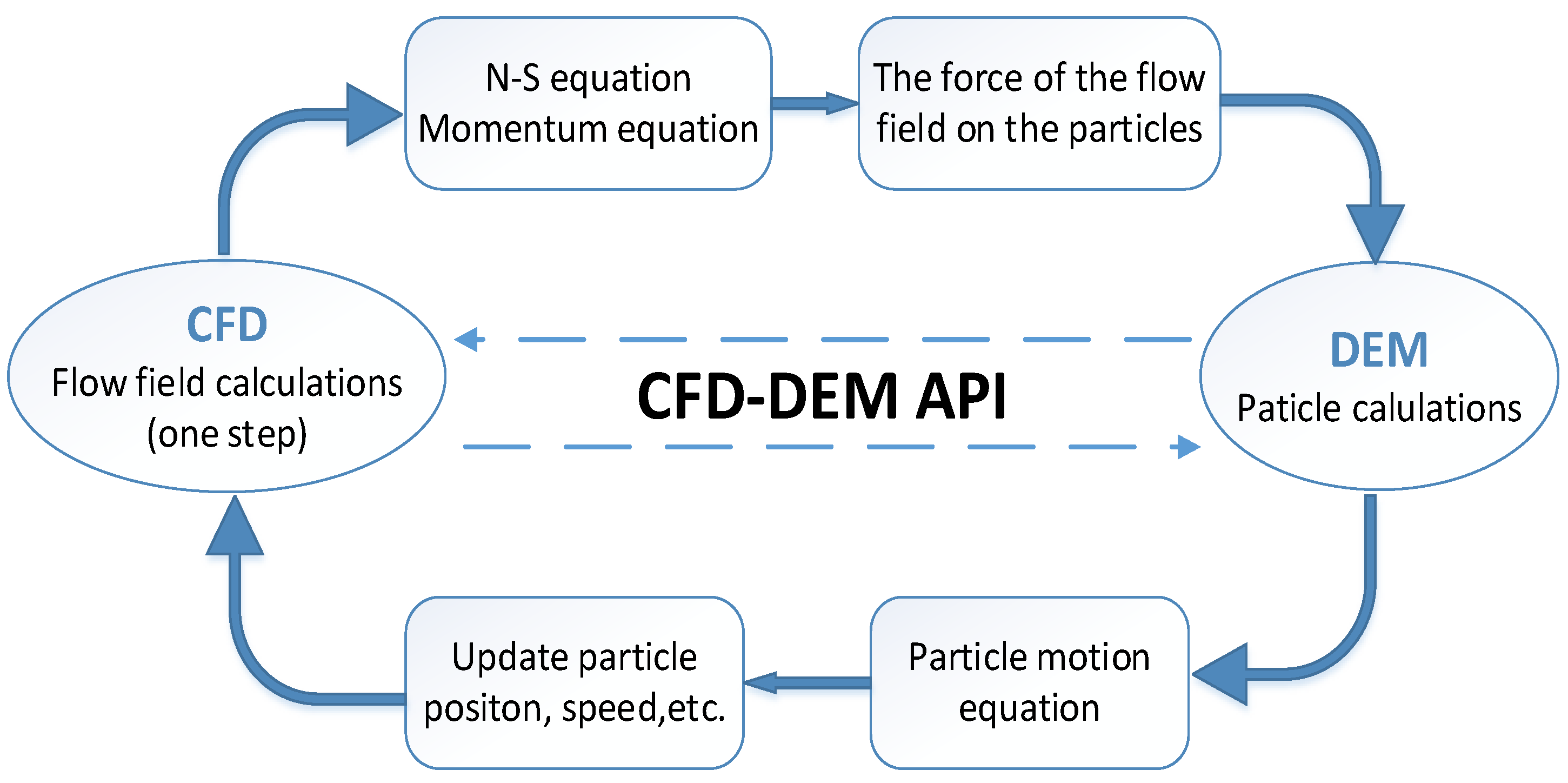
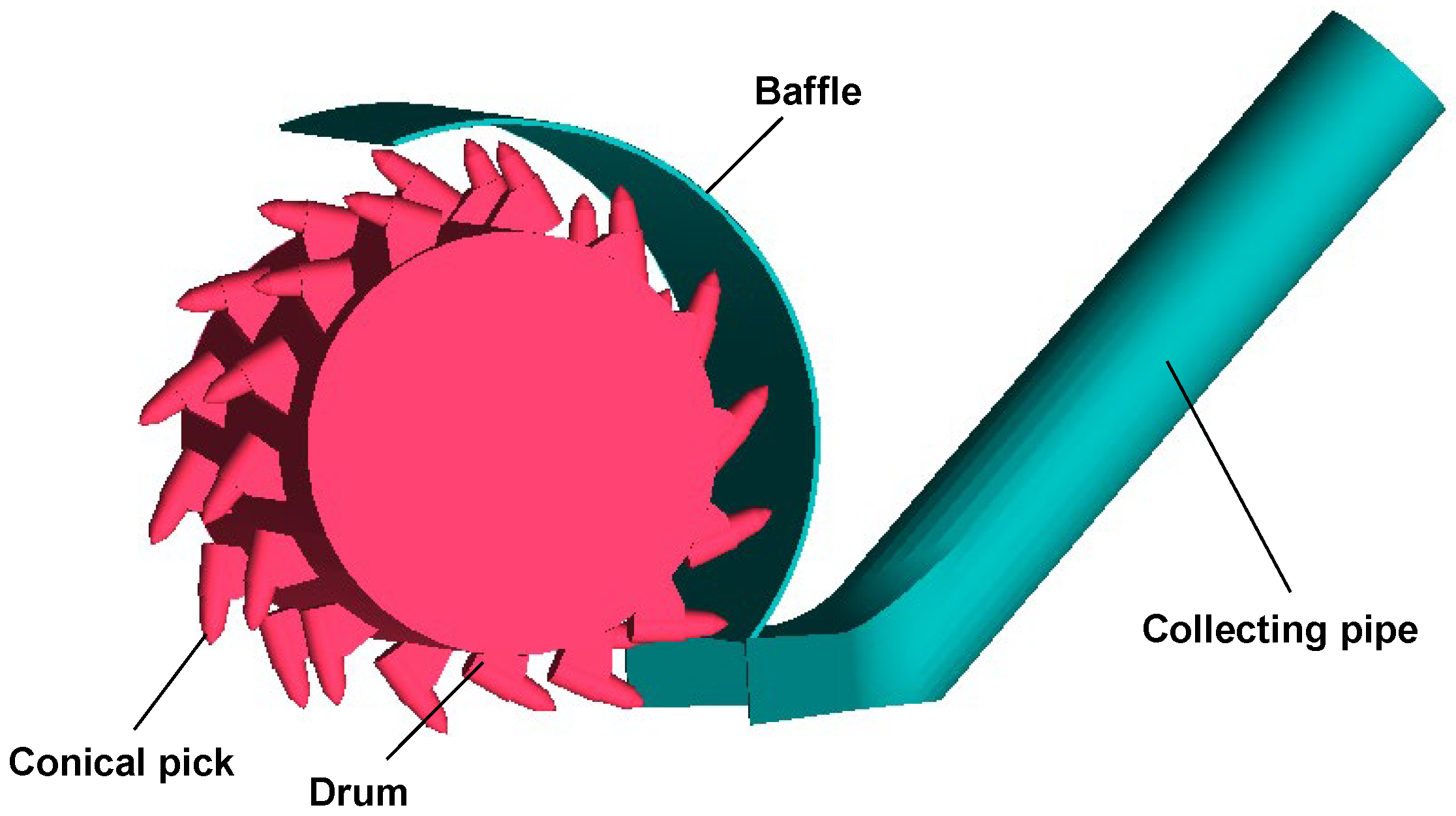



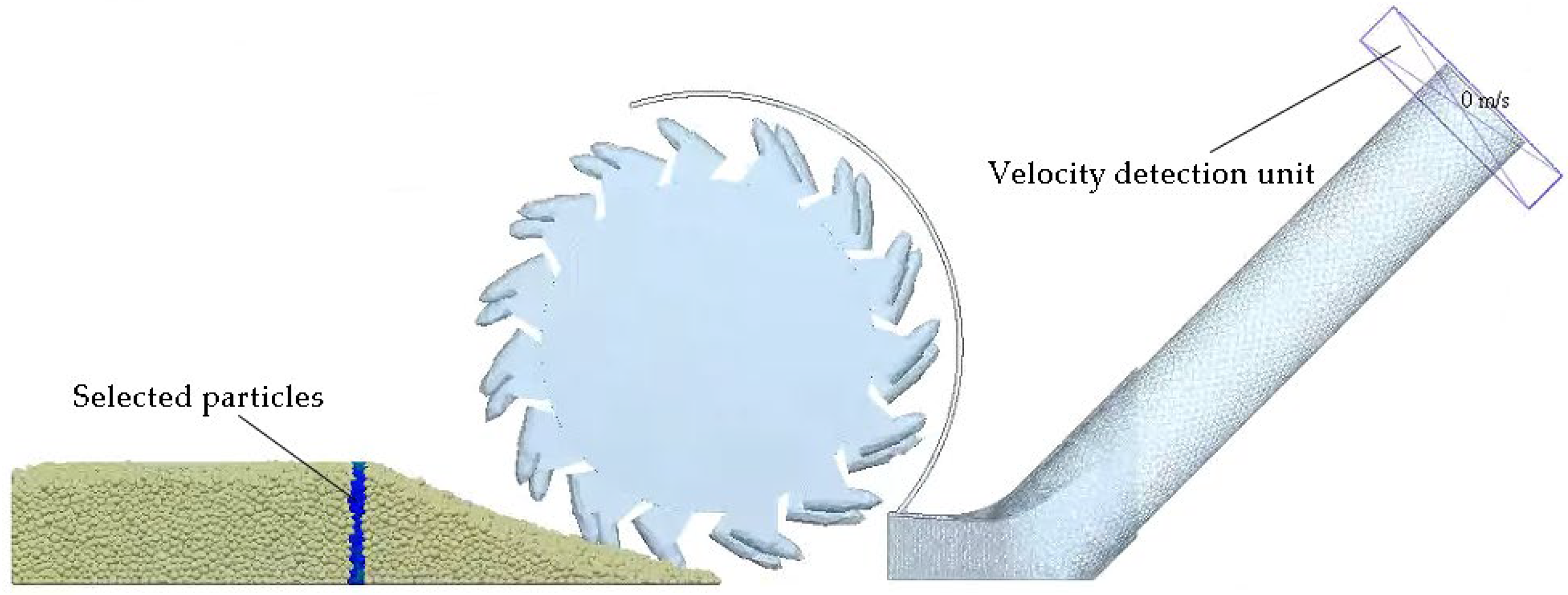

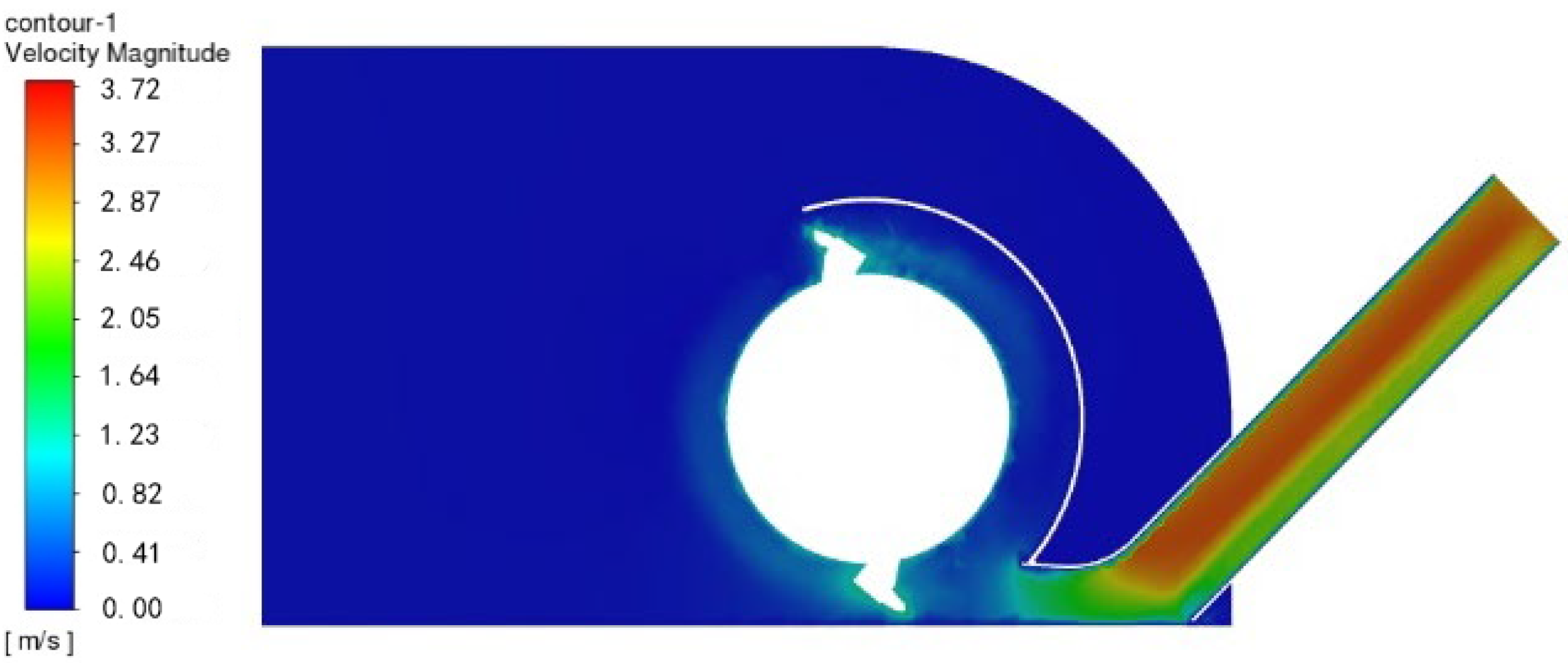
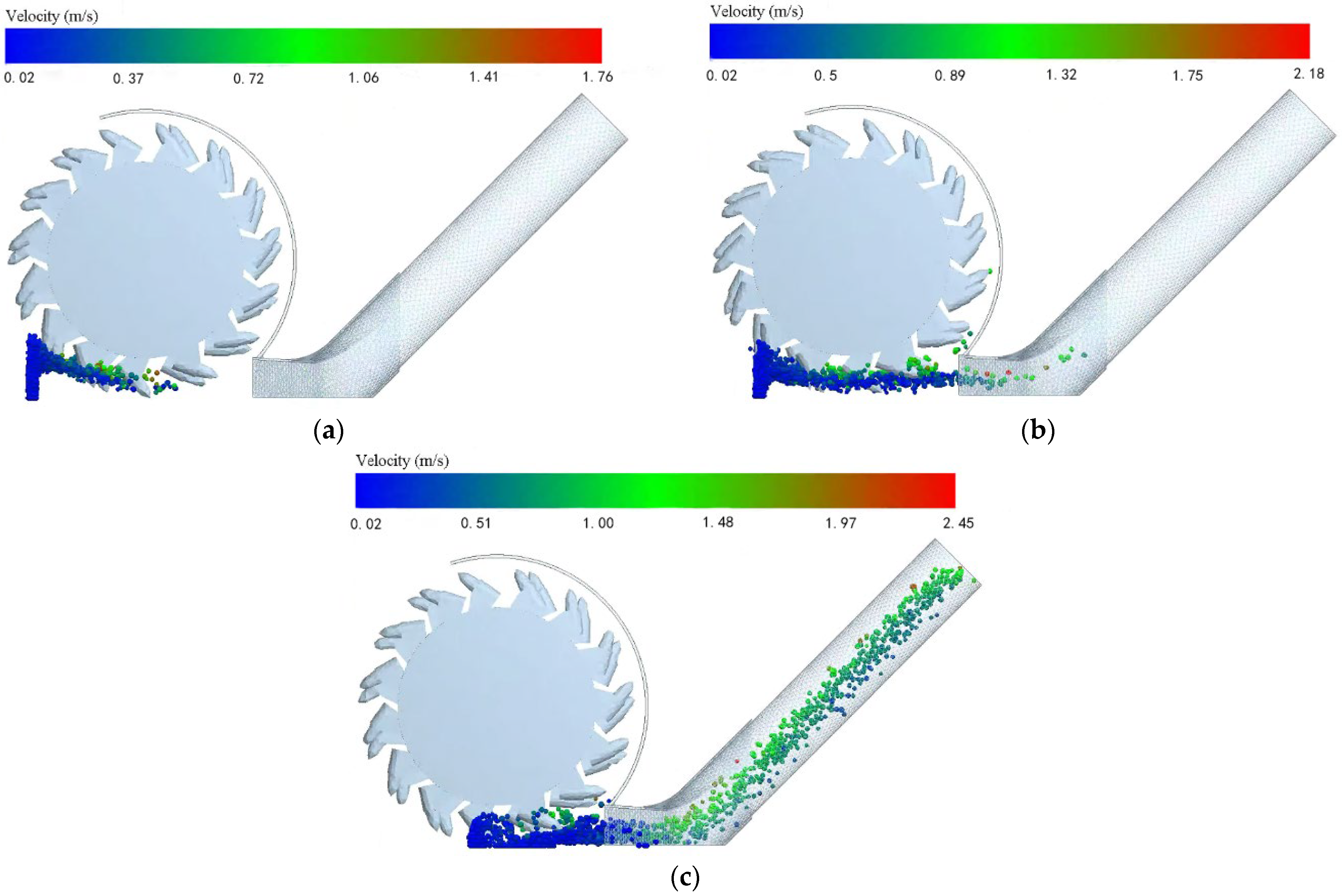
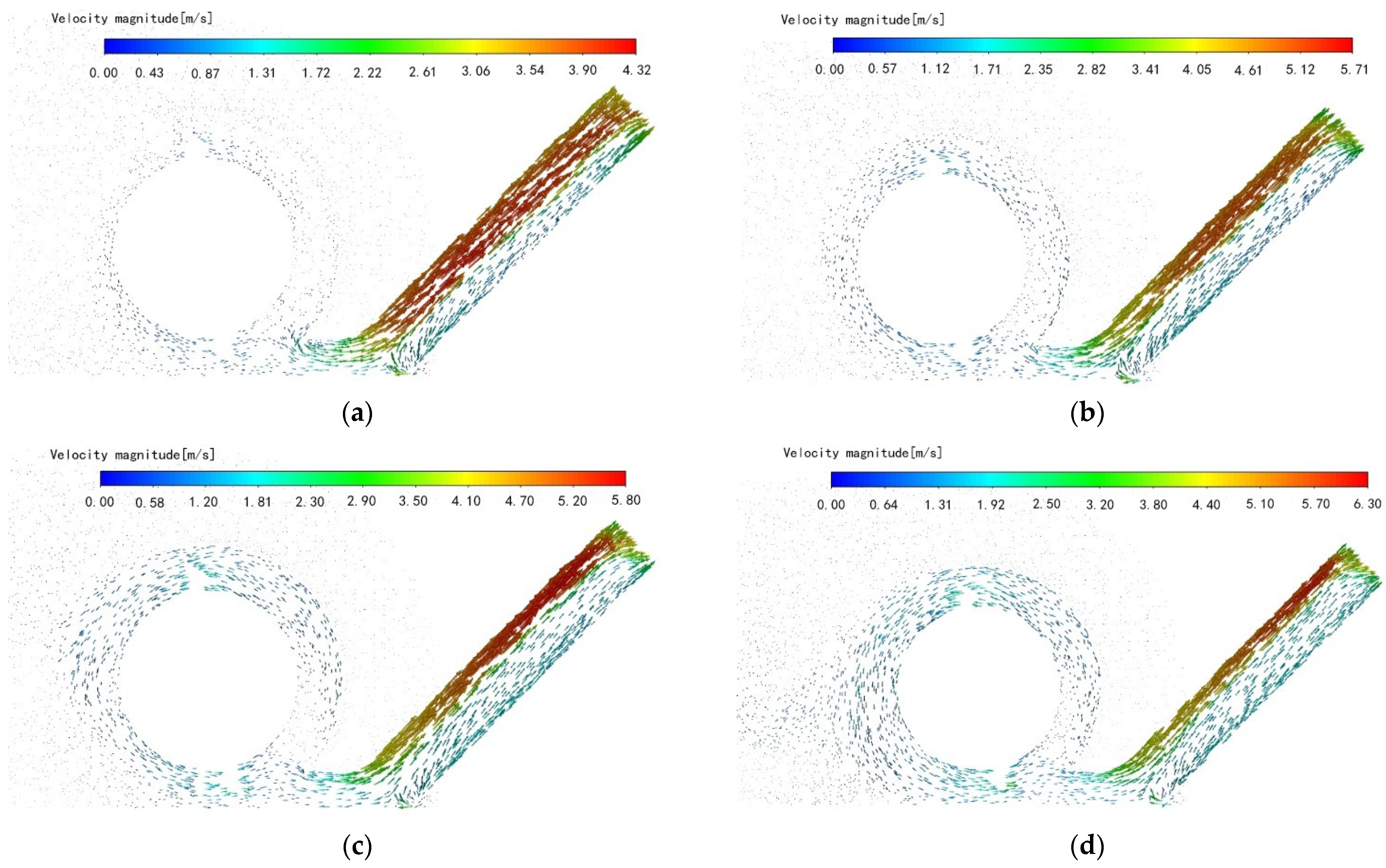

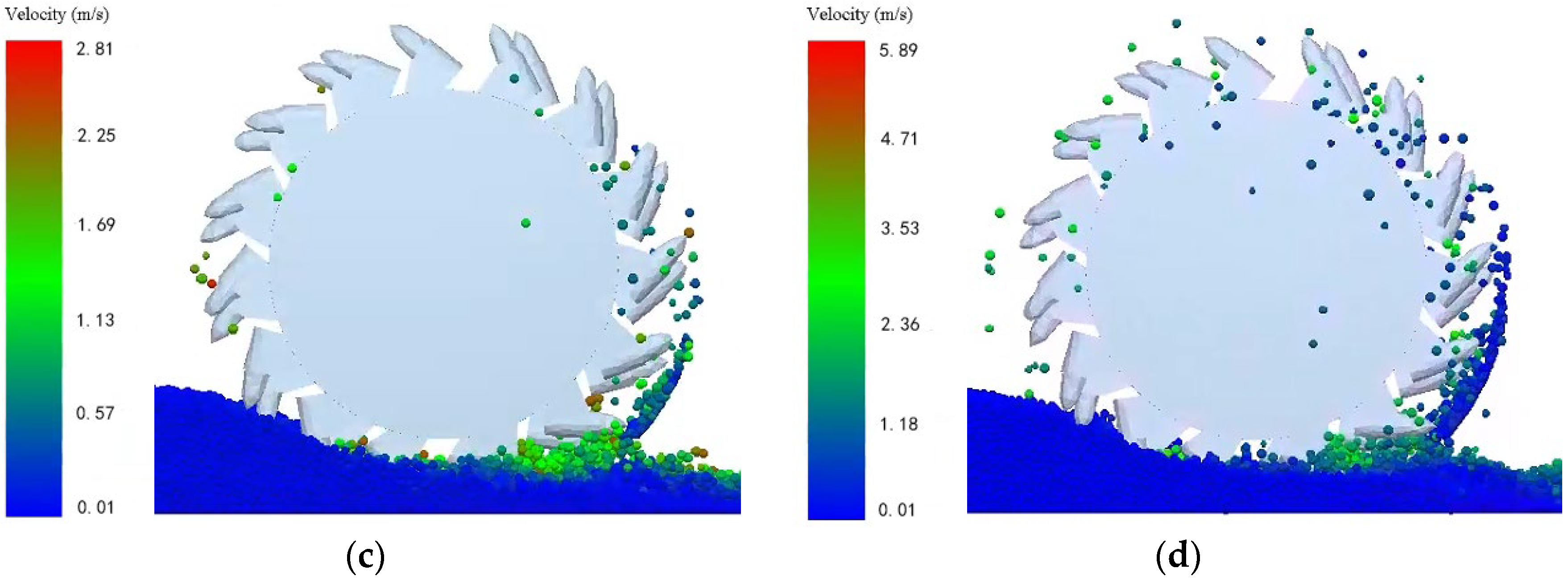

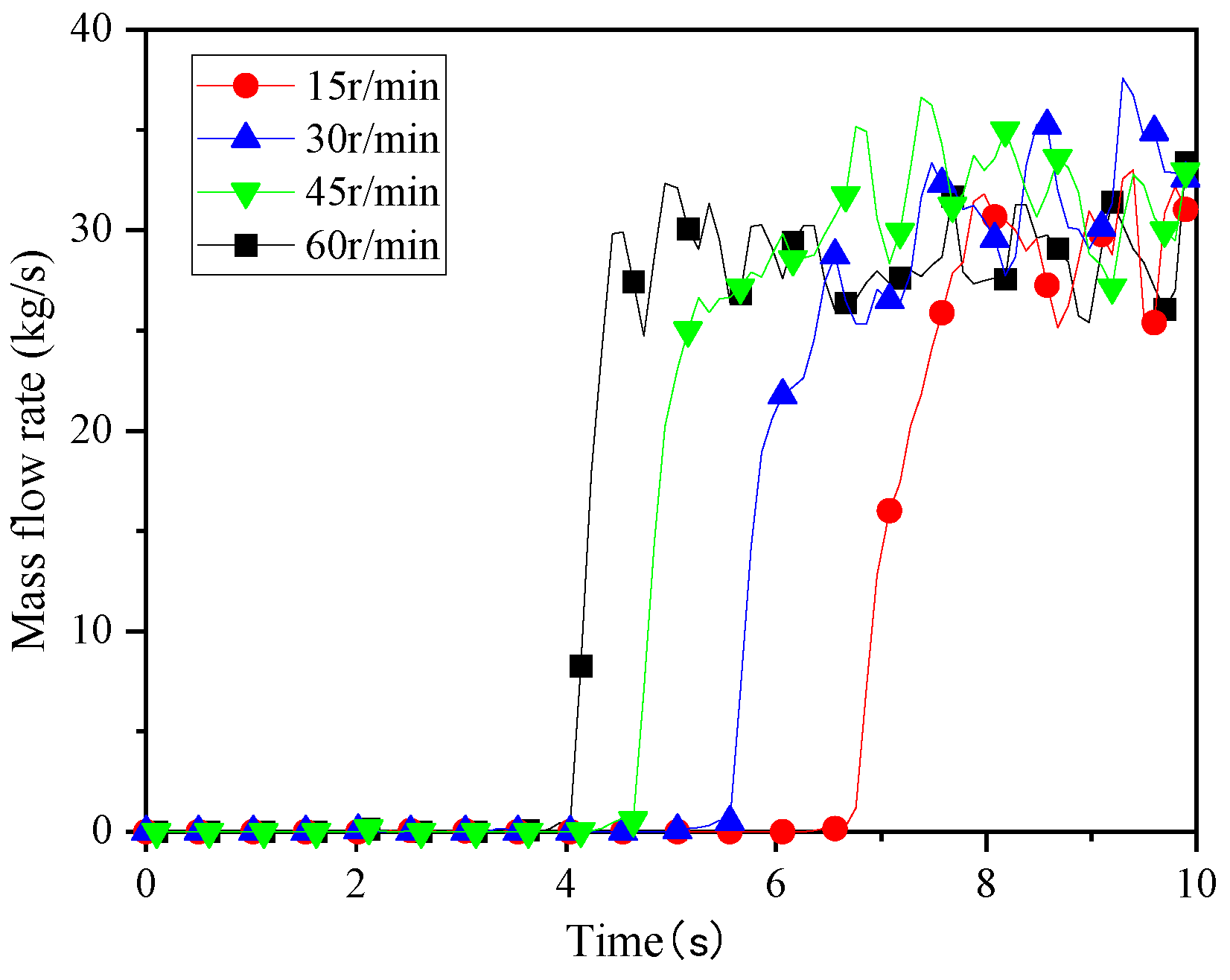
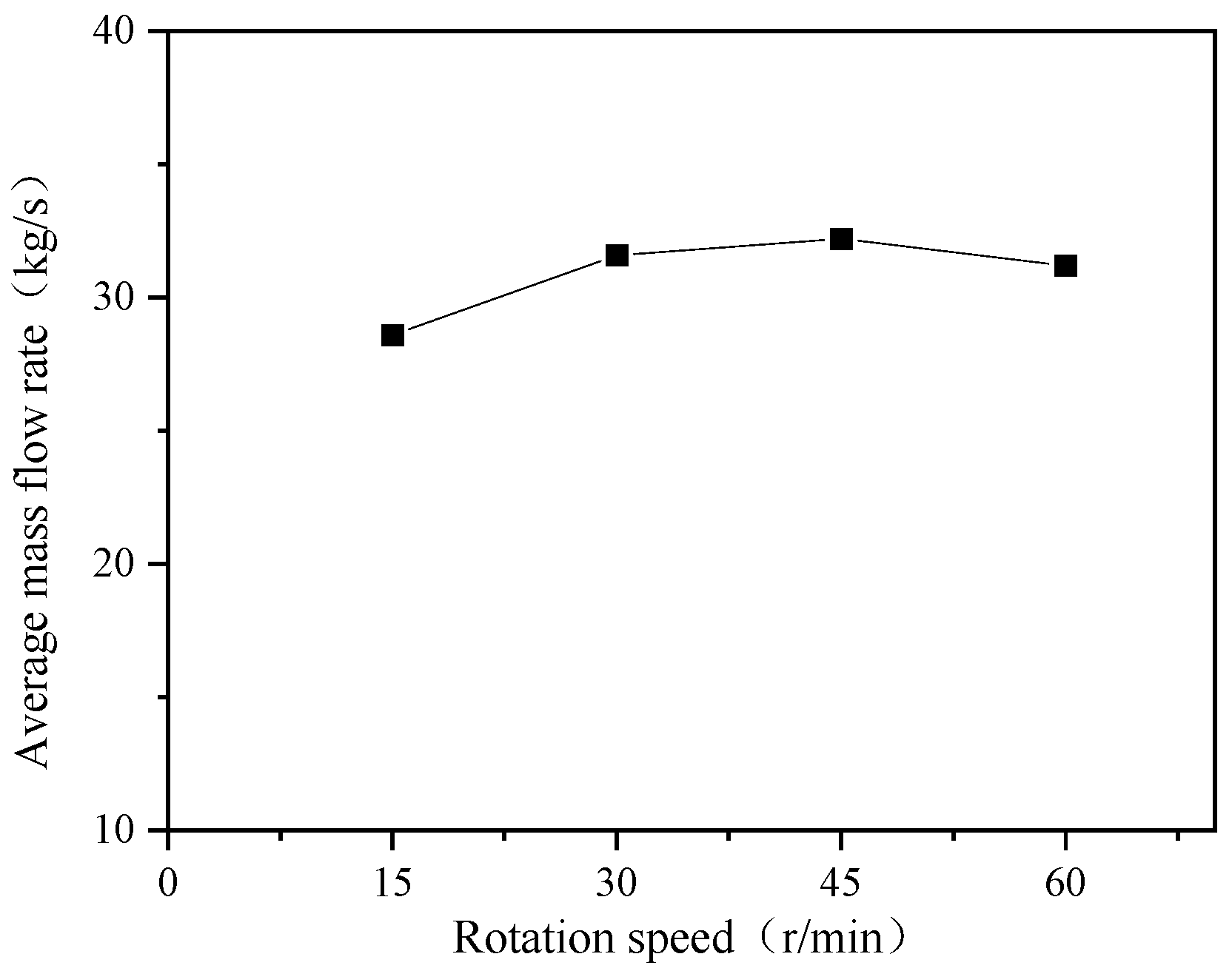
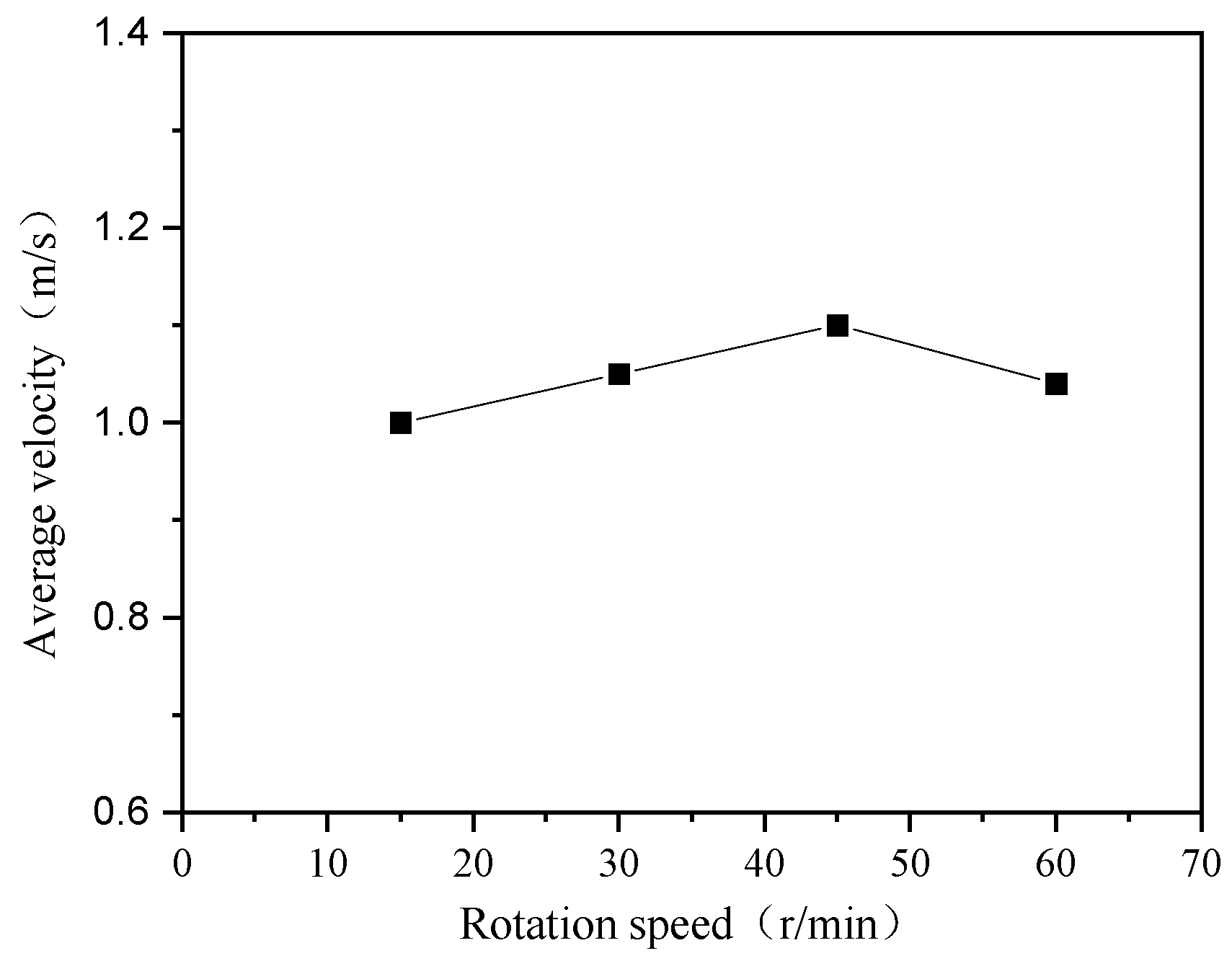

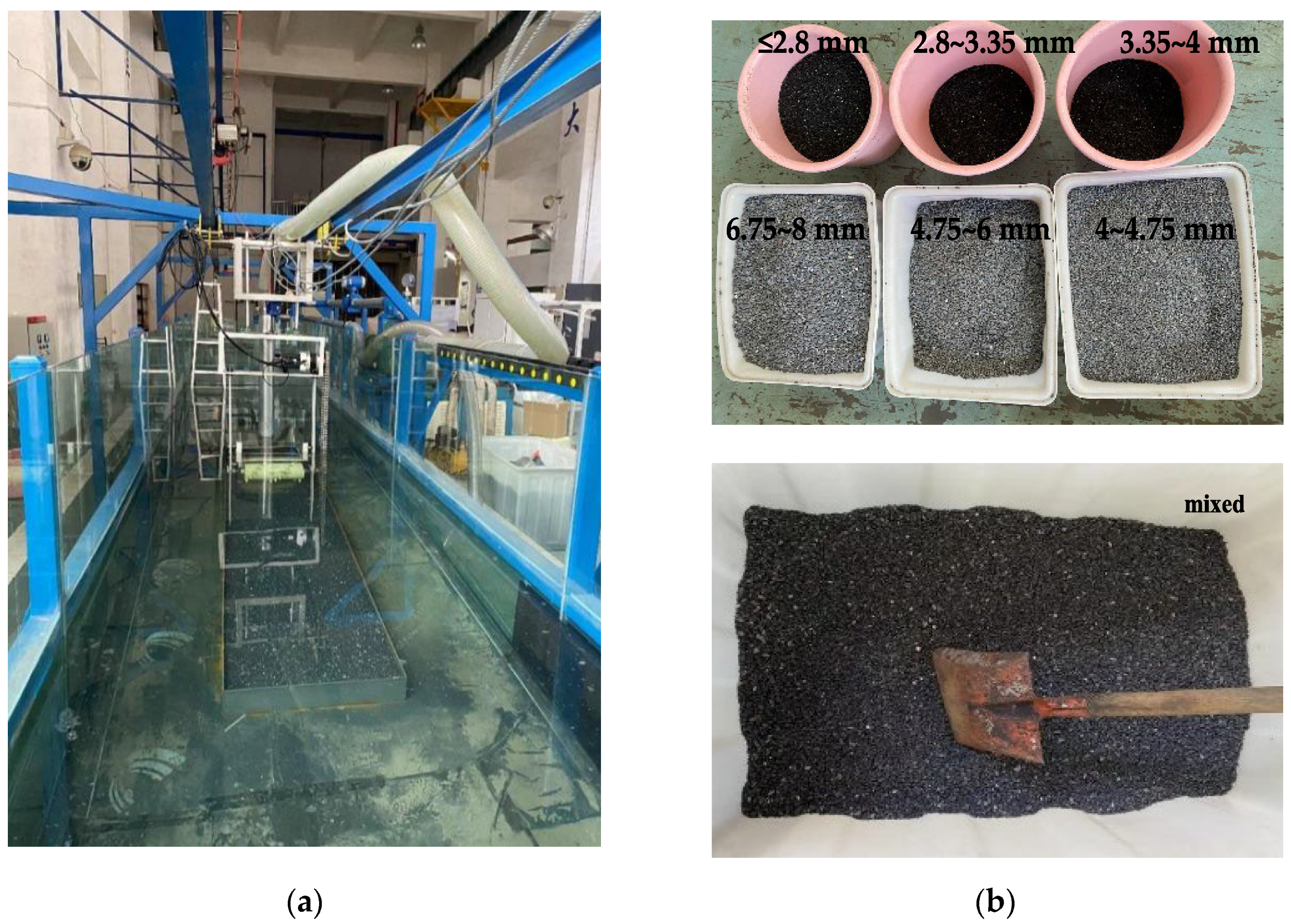
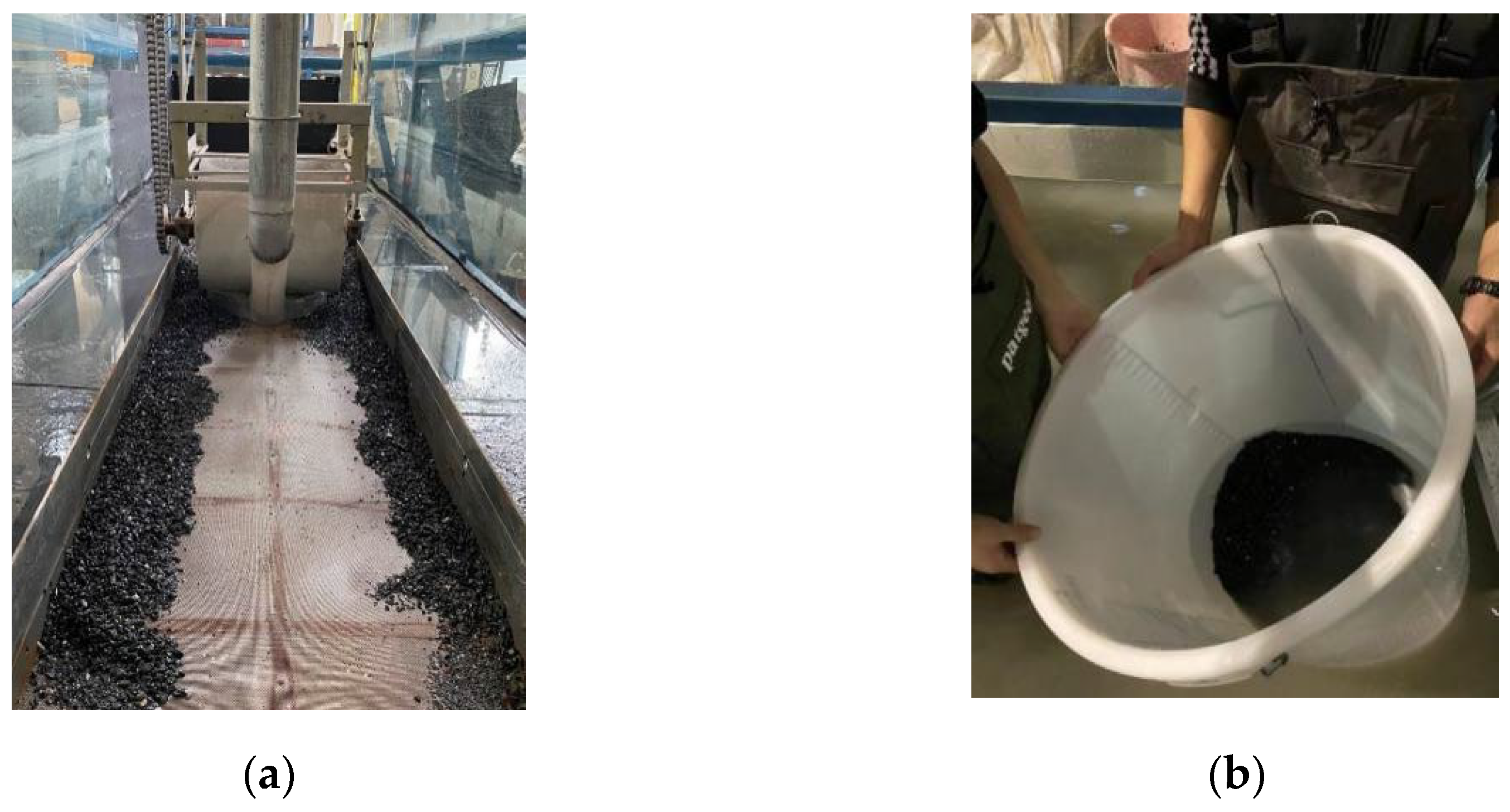
| Cutter Head | Suction Head | ||
|---|---|---|---|
| Parameters | Value | Parameters | Value |
| Diameter (m) | 1 | L (m) | 1 |
| Width (m) | 1 | H (m) | 0.2 |
| Drum diameter (m) | 0.76 | B (m) | 0.4 |
| Number of teeth | 30 | (°) | 120 |
| Installation angle (°) | 45 | d (m) | 0.235 |
| (°) | 135 | ||
| Particle Size Range/mm | Value | F(d) | Mass Ratio of Particle Size Range |
|---|---|---|---|
| ≤5.9 | 5.9 | 0.08 | 8% |
| 5.9~7 | 6.3 | 0.1407 | 6.07% |
| 7~8.39 | 7.8 | 0.2472 | 10.65% |
| 8.39~10 | 9.5 | 0.4104 | 16.32% |
| 10~11.88 | 11.1 | 0.6186 | 20.82% |
| 11.88~16.75 | 14.5 | 0.9598 | 34.12% |
| 16.75~20 | 18.2 | 1 | 4.02% |
| Parameter | Similarity Ratio | |
|---|---|---|
| Type | Name | |
| Geometric parameters | Diameter, width, tooth spacing, cross-sectional depth | |
| angle, number of teeth | 1 | |
| Operation parameters | Rotating speed | |
| Forward speed, outlet velocity of the fluid | ||
| Particle | Density | 1 |
| Particle size | ||
| Result | Volume concentration | 1 |
| Mass flow | ||
| Forward Speed (m/s) | Rotation Speed (r/min) | Outlet Velocity (×10−2 m/s) | ||
|---|---|---|---|---|
| Case 1 | Simulation | 0.047 | 60 | 3 |
| Experiment | 0.03 | 95 | 1.87 | |
| Case 2 | Simulation | 0.047 | 60 | 3.62 |
| Experiment | 0.03 | 95 | 2.29 |
| Mass Flow Rate (kg/s) | Volume Concentration (%) | |||||
|---|---|---|---|---|---|---|
| Test | Error | Simulation | Test | Error | ||
| Case 1 | 1.87 | 1.74 | 7.7% | 5.08 | 4.95 | 2.6% |
| Case 2 | 1.92 | 1.87 | 2.7% | 4.46 | 4.25 | 4.9% |
Disclaimer/Publisher’s Note: The statements, opinions and data contained in all publications are solely those of the individual author(s) and contributor(s) and not of MDPI and/or the editor(s). MDPI and/or the editor(s) disclaim responsibility for any injury to people or property resulting from any ideas, methods, instructions or products referred to in the content. |
© 2024 by the authors. Licensee MDPI, Basel, Switzerland. This article is an open access article distributed under the terms and conditions of the Creative Commons Attribution (CC BY) license (https://creativecommons.org/licenses/by/4.0/).
Share and Cite
Dai, H.; Li, Y. Research on the Collection Characteristics of a Hydraulic Collector for Seafloor Massive Sulfides. J. Mar. Sci. Eng. 2024, 12, 1534. https://doi.org/10.3390/jmse12091534
Dai H, Li Y. Research on the Collection Characteristics of a Hydraulic Collector for Seafloor Massive Sulfides. Journal of Marine Science and Engineering. 2024; 12(9):1534. https://doi.org/10.3390/jmse12091534
Chicago/Turabian StyleDai, Huan, and Yan Li. 2024. "Research on the Collection Characteristics of a Hydraulic Collector for Seafloor Massive Sulfides" Journal of Marine Science and Engineering 12, no. 9: 1534. https://doi.org/10.3390/jmse12091534
APA StyleDai, H., & Li, Y. (2024). Research on the Collection Characteristics of a Hydraulic Collector for Seafloor Massive Sulfides. Journal of Marine Science and Engineering, 12(9), 1534. https://doi.org/10.3390/jmse12091534





